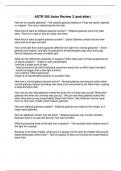Exam (elaborations)
ETH306W Answers to Past Papers Intermediate phase
- Course
- Institution
ETH306W Answers to Past Papers Intermediate phase. ETH306W - Inclusive Education B Inclusive education is the policy target of white paper 6 on special needs education. Provide 10 reasons why SA adopted this policy. (10) - It is a human right - It makes good educational sense - It makes go...
[Show more]




